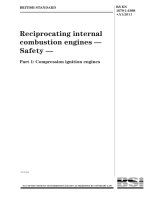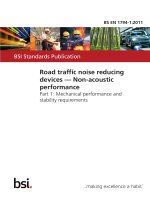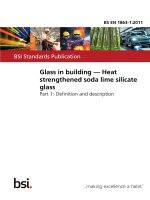Bsi bs en 00527 1 2011
Bạn đang xem bản rút gọn của tài liệu. Xem và tải ngay bản đầy đủ của tài liệu tại đây (1 MB, 26 trang )
BS EN 527-1:2011
BSI Standards Publication
Office furniture — Work tables
and desks
Part 1: Dimensions
BS EN 527-1:2011
BRITISH STANDARD
National foreword
This British Standard is the UK implementation of EN 527-1:2011. It
supersedes BS EN 527-1:2000 which is withdrawn.
The UK participation in its preparation was entrusted to Technical
Committee FW/0/3, Office Furniture.
A list of organizations represented on this committee can be
obtained on request to its secretary.
This publication does not purport to include all the necessary
provisions of a contract. Users are responsible for its correct
application.
© BSI 2011
ISBN 978 0 580 64930 1
ICS 97.140
Compliance with a British Standard cannot confer immunity from
legal obligations.
This British Standard was published under the authority of the
Standards Policy and Strategy Committee on 31 May 2011.
Amendments issued since publication
Date
Text affected
BS EN 527-1:2011
EN 527-1
EUROPEAN STANDARD
NORME EUROPÉENNE
EUROPÄISCHE NORM
May 2011
ICS 97.140
Supersedes EN 527-1:2000
English Version
Office furniture - Work tables and desks - Part 1: Dimensions
Mobilier de bureau - Tables de travail de bureau - Partie 1:
Dimensions
Büromưbel - Büro-Arbeitstische - Teil 1: Me
This European Standard was approved by CEN on 24 March 2011.
CEN members are bound to comply with the CEN/CENELEC Internal Regulations which stipulate the conditions for giving this European
Standard the status of a national standard without any alteration. Up-to-date lists and bibliographical references concerning such national
standards may be obtained on application to the CEN-CENELEC Management Centre or to any CEN member.
This European Standard exists in three official versions (English, French, German). A version in any other language made by translation
under the responsibility of a CEN member into its own language and notified to the CEN-CENELEC Management Centre has the same
status as the official versions.
CEN members are the national standards bodies of Austria, Belgium, Bulgaria, Croatia, Cyprus, Czech Republic, Denmark, Estonia,
Finland, France, Germany, Greece, Hungary, Iceland, Ireland, Italy, Latvia, Lithuania, Luxembourg, Malta, Netherlands, Norway, Poland,
Portugal, Romania, Slovakia, Slovenia, Spain, Sweden, Switzerland and United Kingdom.
EUROPEAN COMMITTEE FOR STANDARDIZATION
COMITÉ EUROPÉEN DE NORMALISATION
EUROPÄISCHES KOMITEE FÜR NORMUNG
Management Centre: Avenue Marnix 17, B-1000 Brussels
© 2011 CEN
All rights of exploitation in any form and by any means reserved
worldwide for CEN national Members.
Ref. No. EN 527-1:2011: E
BS EN 527-1:2011
EN 527-1:2011 (E)
Contents
Page
Foreword ..............................................................................................................................................................3
Introduction .........................................................................................................................................................4
1
Scope ......................................................................................................................................................5
2
Normative references ............................................................................................................................5
3
Terms and definitions ...........................................................................................................................5
4
4.1
4.2
Dimensions .............................................................................................................................................6
Measurement procedure .......................................................................................................................6
Requirements .........................................................................................................................................6
Annex A (informative) General ergonomic principles and explanations to Table 1 .................................. 12
A.1
General ................................................................................................................................................. 12
A.2
Anthropometric data for sitting and standing work ........................................................................ 12
Bibliography ..................................................................................................................................................... 22
2
BS EN 527-1:2011
EN 527-1:2011 (E)
Foreword
This document (EN 527-1:2011) has been prepared by Technical Committee CEN/TC 207 “Furniture”, the
secretariat of which is held by UNI.
This European Standard shall be given the status of a national standard, either by publication of an identical
text or by endorsement, at the latest by November 2011, and conflicting national standards shall be withdrawn
at the latest by November 2011.
Attention is drawn to the possibility that some of the elements of this document may be the subject of patent
rights. CEN [and/or CENELEC] shall not be held responsible for identifying any or all such patent rights.
This document supersedes EN 527-1:2000.
According to the CEN/CENELEC Internal Regulations, the national standards organizations of the following
countries are bound to implement this European Standard: Austria, Belgium, Bulgaria, Croatia, Cyprus, Czech
Republic, Denmark, Estonia, Finland, France, Germany, Greece, Hungary, Iceland, Ireland, Italy, Latvia,
Lithuania, Luxembourg, Malta, Netherlands, Norway, Poland, Portugal, Romania, Slovakia, Slovenia, Spain,
Sweden, Switzerland and the United Kingdom.
3
BS EN 527-1:2011
EN 527-1:2011 (E)
Introduction
Various designs of furniture for general office use exist as a consequence of rapid technological evolutions.
This European Standard relates to office furniture of contemporary design.
The dimensions in this standard are based on the requirements of anthropometric measurements, mechanical
design, subjective preference and other factors.
th
th
The dimensional requirements of the tables and desks are based upon the 5 and 95 percentile of the
th
th
European office user group. In general, this is the 5 percentile female and the 95 percentile male (from
1493 mm to 1913 mm for the stature height). To accomplish the needs of users outside this range, individual
th
th
solutions can be applied. Some European countries can have 5 percentile females and/or 95 percentile
males outside this European user group.
4
BS EN 527-1:2011
EN 527-1:2011 (E)
1
Scope
This European Standard specifies dimensions of work tables and desks for office tasks to be undertaken in a
seated, a sit stand or standing position.
It includes neither dimensions for storage unit nor those for other tables in the office area or reception desks.
2
Normative references
The following referenced documents are indispensable for the application of this document. For dated
references, only the edition cited applies. For undated references, the latest edition of the referenced
document (including any amendments) applies.
N/A
3
Terms and definitions
For the purposes of this document, the following terms and definitions apply.
3.1
height of the work surface
vertical dimension measured from the floor to the top of the work surface at the edge closest to the user
3.2
work table/desk Type A
height adjustable; the height can be changed by the user during use
3.3
work table/desk Type B
height selectable; the height can be adapted to the user at installation
3.4
work table/desk Type C
fixed height
3.5
work table/desk Type D
limited height selectable or adjustable
3.6
sit-stand work table/desk
height adjustable allowing different work positions from seated to standing
3.7
desk top thickness
thickness of the work surface and all protruding parts or elements of the work table/desk within the width and
depth of the legroom
3.8
levelling device
leg component designed to allow the work surface to be set horizontal
5
BS EN 527-1:2011
EN 527-1:2011 (E)
3.9
desk top depth
depth of working surface including any extension elements on the same plane
4
4.1
Dimensions
Measurement procedure
Position the work table/desk on a flat horizontal and rigid floor surface, with levelling device(s) fully closed.
Inclinable desk top work surfaces shall be set to the horizontal or as near to the horizontal as possible.
Before commencing measurement procedure, it shall be determined whether the table/desk is for sitting,
standing or sit/stand use.
The minimum and maximum height of work surface shall be measured at the front edge (see Figure 1) and
the adjustment range shall be recorded. For height selectable work tables/desks type B and D the minimum
height increments shall also be recorded.
The legroom depth shall be measured at the working position and with the rear edge of the work table/desk
placed against a vertical wall.
Figure 1 shows the legroom for all work surfaces which have straight front edges at least all along the width,
W, see Table 1. In these cases, the legroom shall be rectangular with dimensions as specified in Table 1.
Figure 2 shows the legroom for all work surfaces with non-straight front edges. In these cases, the legroom
shall be curved with dimensions as specified in Table 1.
4.2
Requirements
The dimensions of tables/desks shall be as specified in Table 1.
6
BS EN 527-1:2011
EN 527-1:2011 (E)
Table 1 — Table/desk dimensions in millimetres
Type A
Fully adjustable
Dimensions
Sitting only
Minimum range
Work table/desk type
Type B
Type C
Fully
Fixed height
selectable
740 ± 20
Minimum
range
650 - 850
650 - 850
h1
Height of the
work surface
Standing only
Minimum range
950 - 1250
Type D
Limited adjustable or limited
e
selectable
-allow
Min
Max
+allow
yes
680
760
yes
-allow
Min
Max
+allow
yes
1000
1180
yes
a
Minimum
range
1050 ± 20
950 - 1250 a
Sit/stand
Minimum range
N/a
N/a
Minimum range
650 - 1250
t1
and
t2
k1
Maximum desk
top thickness
(see Figure 1)
Minimum height
of knee
clearance for
standing position
only
680 - 1180
At the front, t1
55 b
55 b
70
70
At 500 mm
from the front
edge, t2
80 b
90 b
100
100
700 d
700 d
700 d
700 d
80
80
80
80
150
150
150
150
Sitting only
and sit/stand
From 600 mm
to 800 mm
from the front
edge, f1
120
120
120
120
Standing only
From front
edge to 150
mm, f2
120
120
120
120
800
800
800
Applies only
to tables with
a height more
than 850 mm
(see Figure 3)
k2
Minimum depth
of knee
clearance for
standing position
only
(see Figure 3)
k3
Minimum depth
of foot clearance
for standing
position only
(see Figure 3)
f1
and
f2
g1
Minimum height
of minimum foot
clearance
Minimum
legroom depth c
(see Figure 1)
Sitting only
and sit/stand
f
800
7
BS EN 527-1:2011
EN 527-1:2011 (E)
Table 1 — Table/desk dimensions in millimetres (continued)
D
W
Minimum desk
g
top depth
Minimum
legroom width
800
800
Sitting only and
sit/stand
1200
1000
850
850
Standing only
790
790
790
790
a
Maximum increment of 20 mm
b
Only applies to sitting and sit/stand work tables/desks
c
The construction of the product shall ensure the minimum legroom depth
d
Measured from the floor
e
The minimum and maximum values shall be obtained
f
g
f
800
800
600 mm can in some situations be acceptable, e.g. when 17" or smaller flat screens are used, providing that the work surface is not against the wall
and that two people are not sitting one in front of each other. Information about these limitations shall be provided with the product
The dimension D is measured as the smallest dimension at the work area
NOTE 1
Users outside of the range given in the introduction may need furniture of different dimensions.
NOTE 2
There is no dimension specified for the width (length) of a work table/desk. The width and shape of the work
tables/desks can vary greatly. The actual size of the work surface depends on the individual user’s needs and task
requirements (see EN ISO 9241-5).
8
BS EN 527-1:2011
EN 527-1:2011 (E)
Dimensions in millimetres
Key
h1
t1
t2
f1
g1
w
height to the top of the work surface
maximum desk top thickness at the front
maximum desk top thickness at 500 mm from the front edge
height of foot clearance
minimum legroom depth
minimum legroom width
Figure 1 — Legroom and height for work tables/desks with straight front edges
9
BS EN 527-1:2011
EN 527-1:2011 (E)
Dimensions in millimetres
Key
h1
t1
t2
f1
g1
w
height to the top of the work surface
maximum desk top thickness at the front
maximum desk top thickness at 500 mm from the front edge
height of foot clearance
minimum legroom depth
minimum legroom width
Figure 2 — Legroom and height for work tables/desks with non-straight front edges
10
BS EN 527-1:2011
EN 527-1:2011 (E)
Key
1
2
3
h1
k1
k2
k3
f2
w
front edge
top of the work surface
floor
height to the top of the work surface
height of knee clearance
depth of knee clearance
depth of foot clearance
height of foot clearance
minimum legroom width
Figure 3 — Foot and knee clearance dimensions for standing position only
11
BS EN 527-1:2011
EN 527-1:2011 (E)
Annex A
(informative)
General ergonomic principles and explanations to Table 1
A.1 General
The functional dimensions of work tables/desks are shown in Table 1. There are four types of desks, A, B, C
and D, based on their height adjustability/selectability. The dimensional requirements vary depending on how
they are used i.e. whether the users are sitting or standing or can vary their posture from sitting to standing
(and anything in between).
The legroom clearance height is determined by the maximum desk top thicknesses t 1 at the front edge and t2
at 500 mm from the front edge. The reason for this is to make the measurement process simpler. The
maximum desk top thickness has been calculated by subtracting the legroom height requirement from height
of the work surface of a fixed height desk. The work tables/desks complying with the Type A and B height of
th
the work surface and the maximum desk top thickness requirements will accommodate the 95 percentile
European male.
The minimum foot clearance height is specified to allow a clearance under any part of the rear of the work
surface/desk such as a modesty panel so that users can place their feet on the floor without hitting any part of
the desk. For standing work tables/desks only, there is an additional requirement for the minimum foot
clearance depth so that users standing in front of the table/desk can work without hitting any obstruction under
the work table/desk.
The minimum legroom depth and width for sitting and sit/stand work tables/desks is shown in Figure 2. For
these work tables/desks, only the legroom depth is specified at knee height and at floor level.This should be
deeper than the depth at knee height in order to allow the users to stretch their legs forward at angle of
30 degrees between their lower leg and the vertical and without their feet hitting any part of the work
table/desk at the floor level.
The minimum desk top depth (800 mm and 600 mm in some situations) can be different from the required
minimum legroom depth. The minimum desk top depth is based on the comfortable eye to monitor distance
which should be between 450 mm to 750 mm as specified in A.2.12 of EN ISO 9241-5:1999.
The minimum legroom width for sitting applications (i.e. the gap between the legs or any part or component of
the work table/desk at the sides) is specified sufficiently large to allow users to rotate their chairs rather than
twist their spines when reaching sideways. The minimum legroom width for standing applications is based on
the distance between the outsides of users’ legs when standing with their legs slightly apart.
The dimensions specified in Table 1 are based upon the following anthropometric data for sitting and standing
work taking limitations in technology into account. Body dimensions shown in Table A.1 for the European
populations are taken from PeopleSize 2008, by Open Ergonomics.
A.2 Anthropometric data for sitting and standing work
The body dimensions which form the basis of the table/desk dimensions given in Table 1 are shown in
Table A.1 for sitting and standing. This anthropometric data is taken from PeopleSize 2008, by Open
Ergonomics.
All dimensions are in mm and appropriate ones include 30 mm shoe heel height as specified in EN ISO 14738.
12
Dimension
hip breadthstand
a
(see Figure Seat to elbow
A.1)
Thigh
b
(see Figure thickness
A.1)
Posterior to
c
(see Figure knee
A.1)
d
(see Figure popliteal height
A.1)
e
(see Figure Body thickness
A.1)
f
(see Figure Foot lengh
A.1)
Top of knee
g
(see Figure height
A.1)
Elbow heighth
(see Figure stand
A.2)
hip breadthsitting
Symbol
689
521
341
291
565
399
227
225
-
437
366
-
1230
979
635
169
128
-
302
95%
male
187
5%
female
Dutch
-
464
n/a
n/a
n/a
n/a
n/a
n/a
n/a
n/a
95%
female
-
304
-
471
218
171
-
112
197
5%
female
-
394
-
612
282
307
-
159
293
95%
male
Italian
-
412
n/a
n/a
n/a
n/a
n/a
n/a
n/a
n/a
95%
female
-
336
963
488
218
190
-
140
199
5%
female
-
432
1219
620
288
341
-
220
279
95%
male
French
-
464
n/a
n/a
n/a
n/a
n/a
n/a
n/a
n/a
95%
female
324
348
969
497
224
220
390
546
131
201
5%
female
407
435
1215
626
289
379
503
677
195
277
95%
male
German
427
472
n/a
n/a
n/a
n/a
n/a
n/a
n/a
n/a
95%
female
-
354
-
-
218
194
549
133
204
5%
female
-
412
-
-
281
296
670
175
287
95%
male
Belgian
Table A.1 — Anthropometric data (including 30 mm shoe thickness)
-
463
n/a
n/a
n/a
n/a
n/a
n/a
n/a
n/a
95%
female
-
372
987
498
223
203
430
540
130
192
5%
female
-
445
1211
633
286
352
550
667
184
292
95%
male
Swedish
-
466
n/a
n/a
n/a
n/a
n/a
n/a
n/a
n/a
95%
female
13
321
346
951
488
220
220
383
537
132
197
5%
female
EN 527-1:2011 (E)
405
432
1208
622
287
377
500
673
194
275
469
n/a
n/a
n/a
n/a
n/a
n/a
n/a
n/a
95%
95%
male female
British
424
BS EN 527-1:2011
-
14
Note : All dimensions are in mm
-
-
-
-
-
-
457
462
= c - e (using
95th%ile 5th%ile within
genders)
1219
70
5%
female
969
963
-
95%
female
1230
59
95%
male
979
59
5%
female
=h
-
95%
female
591
134
95%
male
823
85
5%
female
586
-
95%
female
=a+d
133
95%
male
French
188
59
5%
female
Italian
1215
780
82
95%
male
German
-
-
95%
female
476
71
5%
female
112
95%
male
Belgian
-
-
95%
female
Table A.1 — Anthropometric data (including 30 mm shoe thickness) (continued)
=a+d-g
= a-b
Dimension
Source: PeopleSize 2008, Open Ergonomics Ltd
t1
(desk top
thickness
at front)
t2
(desk top
thickness
at 500mm)
h1
(desk top
height
sitting)
(see Figure
A.3)
h1 (desk
top height
standing)
(see Figure
A.4)
d1
(legroom
depth at
knee)
(see Figure
A.5)
Desk/table
Dimensions
Symbol
Dutch
EN 527-1:2011 (E)
464
987
622
124
62
5%
female
452
-
453
951
580
842
1211
153
92
209
427
1208
775
81
-
-
-
95%
5%
95%
95%
female female male female
British
65
108
95%
male
Swedish
BS EN 527-1:2011
BS EN 527-1:2011
EN 527-1:2011 (E)
Key
a
b
c
d
e
f
g
i
dimension from seat to elbow
thigh thickness
dimension from posterior to knee
popliteal height
body thickness
foot length
top of knee height
eye to monitor distance
Figure A.1 — Dimensions for sitting posture
NOTE
(i) Eye to monitor distance is = 450 mm to 750 mm (EN ISO 9241-5)
15
BS EN 527-1:2011
EN 527-1:2011 (E)
Key
f
h
foot length
elbow height-stand
Figure A.2 — Dimensions for standing posture
The calculations used in determining the dimension of tables/desk are shown below. It should be noted that
these are theoretical approximate dimensions.
16
BS EN 527-1:2011
EN 527-1:2011 (E)
Key
a
d
h1
dimension from seat to elbow
popliteal height
height to the top of the work surface
Figure A.3 — Dimension h1 for sitting posture
Sitting Type C (fixed height):
th
th
h1 = a 95 percentile + d 95 percentile
As can be seen from Table A.1, the Swedish population has the largest seat to elbow height (a) and the
largest popliteal height (d)
Therefore
h1= 292 + 550 = 842
Sitting Type A or B (fully adjustable or selectable):
th
th
h1 minimum = a 5 percentile + d 5 percentile
As can be seen from Table A.1, the British population has the smallest seat to elbow height (a) and the
smallest popliteal height (d)
Therefore
h1 minimum= 197+ 383= 580
th
th
h1 maximum = a 95 percentile + d 95 percentile
As can be seen from Table A.1, the Swedish population has the largest seat to elbow height (a) and the
largest popliteal height (d)
Therefore
h1 maximum = 292 + 550 = 842
17
BS EN 527-1:2011
EN 527-1:2011 (E)
Key
h
h1
elbow height-stand
height to the top of the work surface
Figure A.4 — Dimension h1 for standing posture
Standing Type C (fixed height):
th
th
h1 = (h 95 percentile + h 5 percentile) / 2 = 1061
Standing Type A or B (Fully adjustable or selectable):
th
h1 minimum = h 5 percentile
As can be seen from Table A.1, the British population has the smallest standing elbow height (h)
Therefore
h1 minimum = 951
th
h1 maximum = h 95 percentile
As can be seen from Table A.1, the Dutch population has the largest standing elbow height (h)
Therefore
18
h1 maximum = 1230
BS EN 527-1:2011
EN 527-1:2011 (E)
Key
c
e
d1
dimension from posterior to knee
body thickness
minimum depth of legroom at knee
Figure A.5 — Dimension d1
th
th
d1 = c 95 percentile – e 5 percentile
As can be seen from Table A.1, the Belgian population has the largest difference between posterior to knee
dimension (c) and the body thickness (e)
Therefore
d1= 670 – 194 = 476
19
BS EN 527-1:2011
EN 527-1:2011 (E)
Key
a
b
t1
dimension from seat to elbow
thigh thickness
maximum desk top thickness at the front
Figure A.6 — Dimensions t1
Sitting:
th
th
t1 = a 5 percentile – b 5 percentile
th
As can be seen from Table A.1, the Dutch and French 5 percentile females has the smallest dimension
between the seat to elbow (a) and thigh thickness (b)
Therefore
20
t1 = 187 - 128 = 59
BS EN 527-1:2011
EN 527-1:2011 (E)
Key
a
d
g
t2
dimension from seat to elbow
popliteal height
top of knee height
maximum desk top thickness at 500 mm from the front edge
Figure A.7 — Dimension t2
Sitting:
th
th
th
t2 = a 5 percentile + d 5 percentile – g 5 percentile
th
As can be seen from Table A.1, the UK 5 percentile females has the smallest dimension between the sitting
desk height (h1) and top of knee height (g)
Therefore
t2 = 197 + 383 – 488 = 92
21
BS EN 527-1:2011
EN 527-1:2011 (E)
Bibliography
[1]
EN ISO 9241-5:1999, Ergonomic requirements for office work with visual display terminals (VDTs) —
Part 5: Workstation layout and postural requirements (ISO 9241-5:1998)
[2]
EN ISO 14738, Safety of machinery – Anthropometric requirements for the design of workstations at
machinery (ISO 14738:2002)
[3]
EN 527-2:2002, Office furniture – Work tables and desks – Part 2: Mechanical safety requirements
[4]
People Size 2008 by Open Ergonomics ( />
22
This page deliberately left blank









